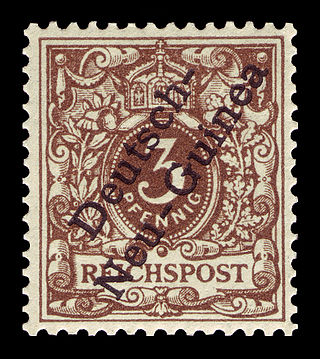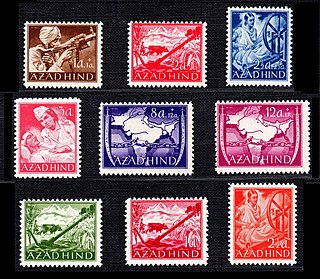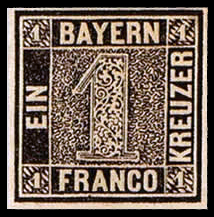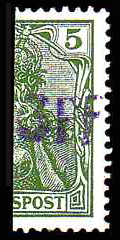
An overprint is an additional layer of text or graphics added to the face of a postage or revenue stamp, postal stationery, banknote or ticket after it has been printed. Post offices most often use overprints for internal administrative purposes such as accounting but they are also employed in public mail. Well-recognized varieties include commemorative overprints which are produced for their public appeal and command significant interest in the field of philately.

The pfennig ; symbol pf or ₰) or penny is a former German coin or note, which was the official currency from the 9th century until the introduction of the euro in 2002. While a valuable coin during the Middle Ages, it lost its value through the years and was the minor coin of the Mark currencies in the German Reich, West Germany and East Germany, and the reunified Germany until the introduction of the euro. Pfennig was also the name of the subunit of the Danzig mark (1922–1923) and the Danzig gulden (1923–1939) in the Free City of Danzig.

Operation Cornflakes was a morale operation by the Office of Strategic Services during World War II that aimed to trick Deutsche Reichspost into inadvertently delivering anti-Nazi propaganda to German citizens through mail.

In general, philatelic fakes and forgeries are labels that look like postage stamps but have been produced to deceive or defraud. Learning to identify these can be a challenging branch of philately.

The postage stamps of New Guinea, part of present-day Papua New Guinea, were issued up to 1942.

SMS Vineta was a protected cruiser of the Victoria Louise class, built for the German Imperial Navy in the 1890s. Vineta was laid down at the AG Vulcan shipyard in 1895, launched in April 1897, and commissioned into the Navy in July 1898. The ship, named for the semi-legendary medieval town of Vineta, was armed with a battery of two 21 cm guns and eight 15 cm guns and had a top speed of 19 knots.

The Azad Hind stamps are a set of prepared but never issued stamps for the planned Provisional Government of Free India under Subhas Chandra Bose. All stamps were printed by photogravure in sheets of 100 at the Reichsdruckerei, the Government Printing Bureau in Berlin.
Postage stamps and postal history of Baden refers to the postal history and postage stamps of the German state of Baden from 1851 to 1871.

This is a survey of the postage stamps and postal history of Germany and philatelically related areas. The main modern providers of service were the Reichspost (1871–1945), the Deutsche Post under Allied control (1945–1949), the Deutsche Post of the GDR (1949–1990), the Deutsche Bundespost (1949–1995), along with the Deutsche Bundespost Berlin (1949–1990), and are now the Deutsche Post AG.

The Deutsche Post (DP), also Deutsche Post of the GDR was the state-owned postal and telecommunications monopoly of the German Democratic Republic. The DP was placed under the control of the Ministry for Postal and Telecommunication Services of the GDR(Ministerium für Post- und Fernmeldewesen der DDR - ) - a member of the Council of Ministers of the GDR(Ministerrat der DDR) - and was in operation from 1949 until the reunification of Germany on 3 October 1990.

Germania stamps are definitive stamps that were issued by the German Empire and the Weimar Republic between 1900 and 1922, depicting Germania. They represent the longest running series in German philately and are in their many variations and derivations an essential part of German philatelic collections.

The German post offices abroad were an extraterritorial network of German post offices in foreign countries with a significant German commercial interest to provide mail service where the local services were generally deemed unsafe or unreliable, such as China, Morocco, Ottoman Empire and Zanzibar. The system ended during or shortly after World War I.
The German Post Offices Abroad were a network of post offices in foreign countries established by Germany to provide mail service where the local services were deemed unsafe or unreliable. They were generally set up in cities with some sort of German commercial interest. In the earliest period when such offices were open, stamps used there can only be identified by their cancellations. Such stamps are known as "Vorläufer" (forerunner) stamps. Later stamps issued for use at a post office abroad can generally be identified by overprints even when not postally used. Germany began issuing distinctive stamps for use overseas beginning in the late 19th century, and the number and variety of issues reached its heyday at the beginning of the 20th century. All German Post Offices Abroad were closed down during or shortly after World War I.
The German post offices abroad were a network of post offices in foreign countries established by Germany to provide mail service where the local services were deemed unsafe or unreliable. They were generally set up in cities with some sort of German commercial interest. In early use only the cancellation mark can identify their postal use abroad; such stamps are known as "Vorläufer" (forerunner) stamps. Later stamps are identified by overprints even when not postally used. German abroad stamps started appearing in the late 19th century and reached their heyday at the beginning of the 20th century; they closed down during or shortly after World War I.

The German post offices abroad were a network of post offices in foreign countries established by Germany to provide mail service where the local services were deemed unsafe or unreliable. They were generally set up in cities with some sort of German commercial interest. In early use only the cancellation mark can identify their postal use abroad; such stamps are known as "Vorläufer" (forerunner) stamps. Later stamps are identified by overprints even when not postally used. German abroad stamps started appearing in the late 19th century and reached their heyday at the beginning of the 20th century; they closed down during or shortly after World War I.

The postage stamps and postal history of Papua New Guinea originated in the two colonial administrations on the eastern part of the island of New Guinea and continued until their eventual merger, followed by independence in 1975.

This is a survey of postage stamps and postal history of the German colonies and part of the postage stamps and postal history of Germany, as well as those of the individual countries and territories concerned.

SS Cap Polonio was a German 20,576 GRT ocean liner that was launched in 1914 and scrapped in 1935. She worked the Hamburg Südamerikanische Dampfschifffahrtsgesellschaft route between Hamburg in Germany and Buenos Aires in Argentina. She was named after Cabo Polonio in Uruguay.

A Schüsselpfennig, also Gehulchter Pfennig is so called due to the stamping technique which results in a concave, one-sided type of Pfennig coin. It was probably first minted in 1374 in the Palatinate. Small Schüsselpfennigs that had entered the Electorate of Saxony were referred to there as Näpfchenheller.
This page is based on this
Wikipedia article Text is available under the
CC BY-SA 4.0 license; additional terms may apply.
Images, videos and audio are available under their respective licenses.
















